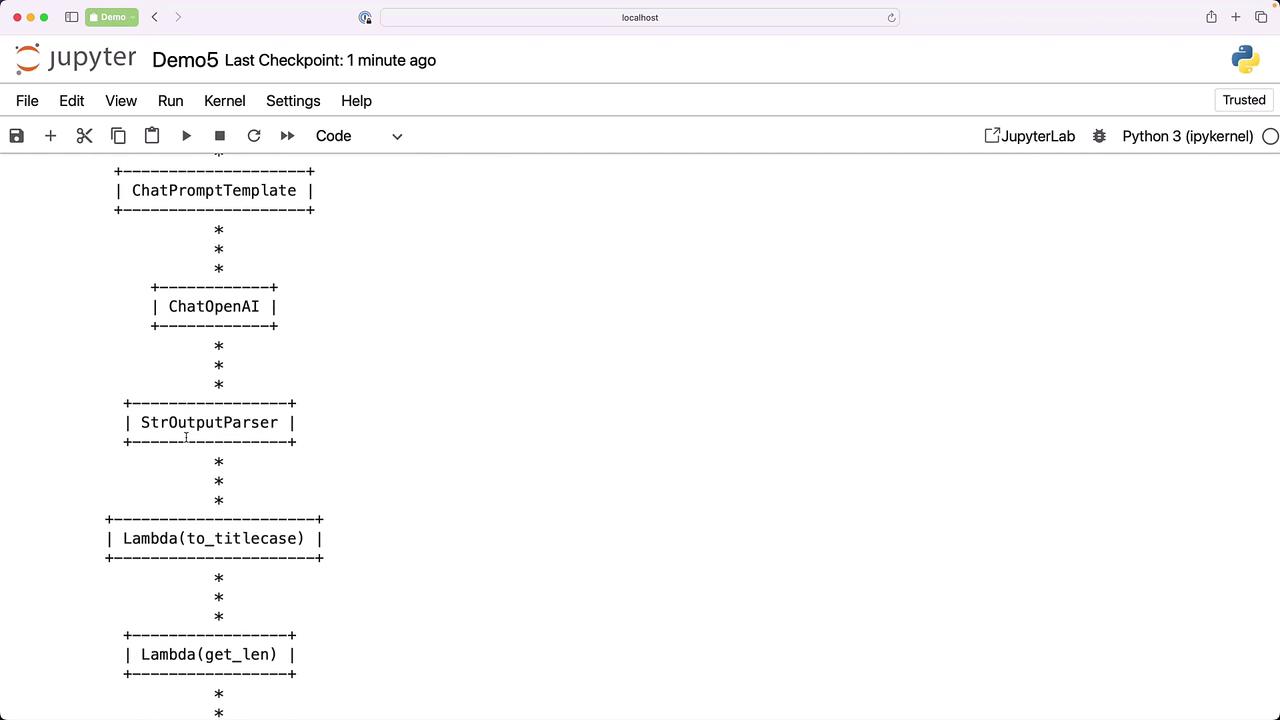LangChain
Introduction to LCEL
LCEL Demo 6
In this lesson, we dive into advanced LCEL patterns by injecting custom logic into your pipelines and inspecting their internal structure. You’ll learn how to:
- Build a basic LCEL chain.
- Wrap Python functions as
RunnableLambdacomponents. - Debug and compute additional metrics.
- Visualize and explore your chain graph with
grandalf.
1. Creating a Basic LCEL Chain
Start by defining a simple chain that generates a one-line description for any topic using OpenAI’s Chat API:
from langchain_core.prompts import ChatPromptTemplate
from langchain_openai import ChatOpenAI
from langchain_core.output_parsers import StrOutputParser
prompt = ChatPromptTemplate.from_template("Give me a one-line description of {topic}")
model = ChatOpenAI()
output_parser = StrOutputParser()
chain = prompt | model | output_parser
result = chain.invoke({"topic": "AI"})
print(result)
# 'AI is the simulation of human intelligence processes by machines, especially computer systems.'
| Component | Purpose | Example |
|---|---|---|
| ChatPromptTemplate | Build the prompt from a template | from_template("Give me a one-line...") |
| ChatOpenAI | Call the OpenAI chat model | ChatOpenAI() |
| StrOutputParser | Parse the raw LLM output | StrOutputParser() |
2. Adding Custom Transformations
You can seamlessly insert your own Python functions into the chain as RunnableLambda components.
def to_titlecase(text: str) -> str:
return text.title()
chain = prompt | model | output_parser | RunnableLambda(to_titlecase)
titlecased = chain.invoke({"topic": "AI"})
print(titlecased)
# 'Ai Is The Simulation Of Human Intelligence Processes By Machines, Especially Computer Systems.'
Note
Use RunnableLambda to wrap any pure Python function and inject it at any stage of your chain.
3. Computing Metrics with Custom Logic
You can further extend the pipeline to compute metrics like text length. Here’s an example that also prints the intermediate value for debugging:
def get_len(text: str) -> int:
print(text) # debug print
return len(text)
chain = (
prompt
| model
| output_parser
| RunnableLambda(to_titlecase)
| RunnableLambda(get_len)
)
length = chain.invoke({"topic": "AI"})
# Prints: 'Ai Is The Simulation Of Human Intelligence Processes By Machines, Especially Computer Systems.'
print(length)
# 94
Warning
Remember to remove or disable debug print statements in production to avoid cluttering your logs.
4. Inspecting Your Chain with Grandalf
To explore the internal graph of your LCEL chain, install the grandalf package:
pip install grandalf # Inspect LCEL chain structure
Retrieve and print the raw graph:
graph = chain.get_graph()
print(graph)
For a clearer hierarchical view, render it as ASCII art:
chain.get_graph().print_ascii()

+---------------------------+
| PromptInput |
+---------------------------+
| * |
+---------------------------+
| ChatPromptTemplate |
+---------------------------+
| * |
+---------------------------+
| ChatOpenAI |
+---------------------------+
| * |
+---------------------------+
| StrOutputParser |
+---------------------------+
| * |
+---------------------------+
| RunnableLambda(to_titlecase) |
+---------------------------+
| * |
+---------------------------+
| RunnableLambda(get_len) |
+---------------------------+
This ASCII diagram illustrates the data flow from prompt generation through model invocation, parsing, custom transformations, and final metric calculation.
5. Next Steps
With custom runnables and introspection in your toolkit, you can combine multiple chains, integrate external APIs, and build complex, maintainable workflows in LCEL.
Links and References
Watch Video
Watch video content
Practice Lab
Practice lab